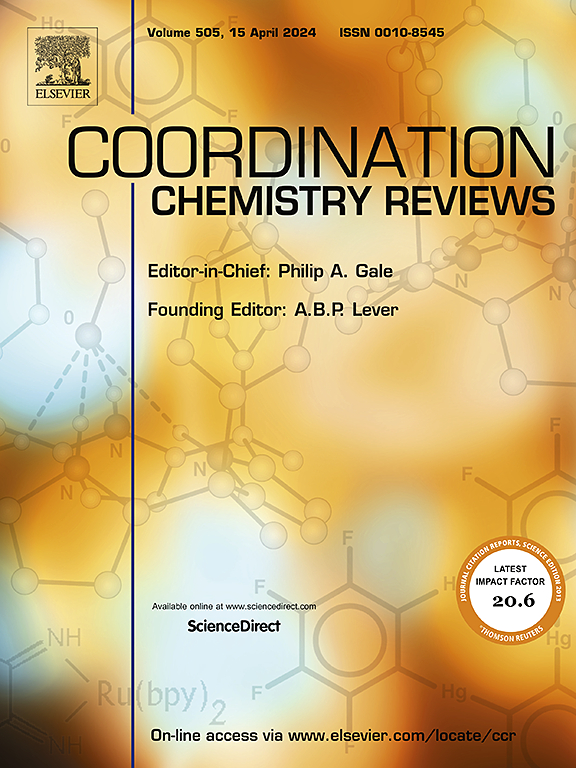Metal-organic frameworks for ethane-selective adsorption: A comprehensive review on structural design and separation applications
IF 20.3
1区 化学
Q1 CHEMISTRY, INORGANIC & NUCLEAR
引用次数: 0
Abstract
Developing adsorption separation processes based on ethane-selective (C2H6-selective) adsorbents to replace energy-intensive cryogenic distillation is a promising alternative to purifying ethylene (C2H4), yet it remains challenging. The emergence of porous metal–organic frameworks (MOFs) has significantly advanced research on C2H6-selective adsorbents, enabling researchers to enhance C2H6-selective adsorption by accurately adjusting the pore size and surface chemical properties of these materials. Although extensive research in this field, the understanding of the structural recognition mechanisms is still insufficient, and further systematic studies are urgently needed to boost the selective adsorption performance of C2H6 and overcome the challenges posed by complex separation systems and industrial applications. This review is the first to systematically summarize the research advancements of C2H6-selective adsorbents during the past 15 years, and deeply explores their structural recognition mechanism, including flexible gate-opening, open-metal sites modification, pore surface regulation and confined pore space. In addition, the development from MOFs to other new porous materials and the application from two-component to multi-component separation system are summarized. Finally, this review offers a concise evaluation of the future development trends of C2H6-selective adsorbents and identifies the challenges that may arise in translating MOFs from academic research to practical industrial applications.


乙烷选择性吸附金属-有机框架:结构设计与分离应用综述
开发基于乙烷选择性(C2H6-selective)吸附剂的吸附分离工艺以取代高能耗的深冷精馏是一种很有前途的提纯乙烯(C2H4)的方法,但仍存在挑战。多孔金属有机骨架(mof)的出现极大地推进了c2h6选择性吸附剂的研究,使研究人员能够通过精确调节这些材料的孔径和表面化学性质来增强c2h6选择性吸附。虽然这一领域的研究非常广泛,但对结构识别机制的认识仍然不足,迫切需要进一步的系统研究来提高C2H6的选择性吸附性能,克服复杂分离系统和工业应用带来的挑战。本文首次系统总结了近15年来c2h6选择性吸附剂的研究进展,深入探讨了c2h6选择性吸附剂的结构识别机制,包括柔性开门、开放金属位点修饰、孔表面调节和受限孔空间等。综述了从MOFs到其他新型多孔材料的发展,以及从双组分到多组分分离体系的应用。最后,本文对c2h6选择性吸附剂的未来发展趋势进行了简要评价,并指出了mof从学术研究到实际工业应用可能出现的挑战。
本文章由计算机程序翻译,如有差异,请以英文原文为准。
求助全文
约1分钟内获得全文
求助全文
来源期刊

Coordination Chemistry Reviews
化学-无机化学与核化学
CiteScore
34.30
自引率
5.30%
发文量
457
审稿时长
54 days
期刊介绍:
Coordination Chemistry Reviews offers rapid publication of review articles on current and significant topics in coordination chemistry, encompassing organometallic, supramolecular, theoretical, and bioinorganic chemistry. It also covers catalysis, materials chemistry, and metal-organic frameworks from a coordination chemistry perspective. Reviews summarize recent developments or discuss specific techniques, welcoming contributions from both established and emerging researchers.
The journal releases special issues on timely subjects, including those featuring contributions from specific regions or conferences. Occasional full-length book articles are also featured. Additionally, special volumes cover annual reviews of main group chemistry, transition metal group chemistry, and organometallic chemistry. These comprehensive reviews are vital resources for those engaged in coordination chemistry, further establishing Coordination Chemistry Reviews as a hub for insightful surveys in inorganic and physical inorganic chemistry.
 求助内容:
求助内容: 应助结果提醒方式:
应助结果提醒方式:


